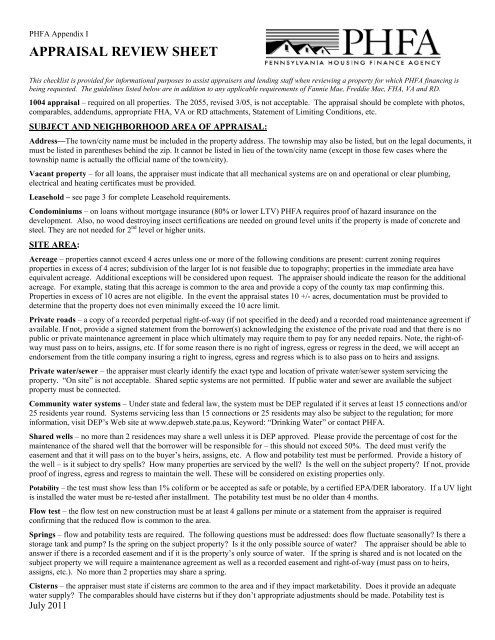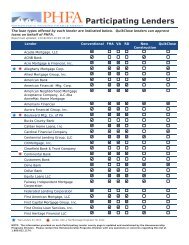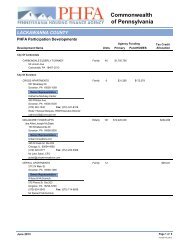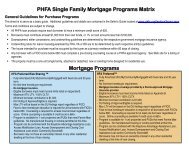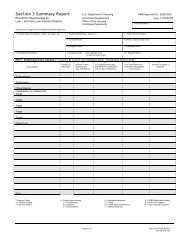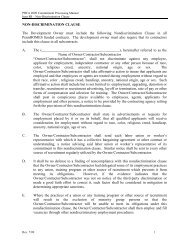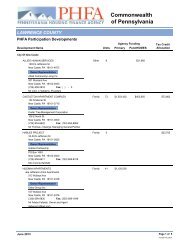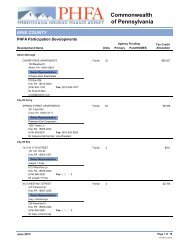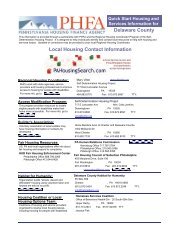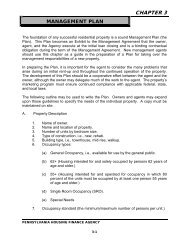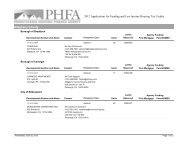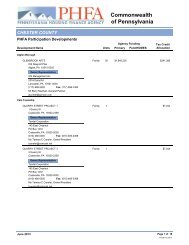PHFA Appraisal Review Sheet
PHFA Appraisal Review Sheet
PHFA Appraisal Review Sheet
You also want an ePaper? Increase the reach of your titles
YUMPU automatically turns print PDFs into web optimized ePapers that Google loves.
<strong>PHFA</strong> Appendix I<br />
APPRAISAL REVIEW SHEET<br />
This checklist is provided for informational purposes to assist appraisers and lending staff when reviewing a property for which <strong>PHFA</strong> financing is<br />
being requested. The guidelines listed below are in addition to any applicable requirements of Fannie Mae, Freddie Mac, FHA, VA and RD.<br />
1004 appraisal – required on all properties. The 2055, revised 3/05, is not acceptable. The appraisal should be complete with photos,<br />
comparables, addendums, appropriate FHA, VA or RD attachments, Statement of Limiting Conditions, etc.<br />
SUBJECT AND NEIGHBORHOOD AREA OF APPRAISAL:<br />
Address—The town/city name must be included in the property address. The township may also be listed, but on the legal documents, it<br />
must be listed in parentheses behind the zip. It cannot be listed in lieu of the town/city name (except in those few cases where the<br />
township name is actually the official name of the town/city).<br />
Vacant property – for all loans, the appraiser must indicate that all mechanical systems are on and operational or clear plumbing,<br />
electrical and heating certificates must be provided.<br />
Leasehold – see page 3 for complete Leasehold requirements.<br />
Condominiums – on loans without mortgage insurance (80% or lower LTV) <strong>PHFA</strong> requires proof of hazard insurance on the<br />
development. Also, no wood destroying insect certifications are needed on ground level units if the property is made of concrete and<br />
steel. They are not needed for 2 nd level or higher units.<br />
SITE AREA:<br />
Acreage – properties cannot exceed 4 acres unless one or more of the following conditions are present: current zoning requires<br />
properties in excess of 4 acres; subdivision of the larger lot is not feasible due to topography; properties in the immediate area have<br />
equivalent acreage. Additional exceptions will be considered upon request. The appraiser should indicate the reason for the additional<br />
acreage. For example, stating that this acreage is common to the area and provide a copy of the county tax map confirming this.<br />
Properties in excess of 10 acres are not eligible. In the event the appraisal states 10 +/- acres, documentation must be provided to<br />
determine that the property does not even minimally exceed the 10 acre limit.<br />
Private roads – a copy of a recorded perpetual right-of-way (if not specified in the deed) and a recorded road maintenance agreement if<br />
available. If not, provide a signed statement from the borrower(s) acknowledging the existence of the private road and that there is no<br />
public or private maintenance agreement in place which ultimately may require them to pay for any needed repairs. Note, the right-ofway<br />
must pass on to heirs, assigns, etc. If for some reason there is no right of ingress, egress or regress in the deed, we will accept an<br />
endorsement from the title company insuring a right to ingress, egress and regress which is to also pass on to heirs and assigns.<br />
Private water/sewer – the appraiser must clearly identify the exact type and location of private water/sewer system servicing the<br />
property. “On site” is not acceptable. Shared septic systems are not permitted. If public water and sewer are available the subject<br />
property must be connected.<br />
Community water systems – Under state and federal law, the system must be DEP regulated if it serves at least 15 connections and/or<br />
25 residents year round. Systems servicing less than 15 connections or 25 residents may also be subject to the regulation; for more<br />
information, visit DEP’s Web site at www.depweb.state.pa.us, Keyword: “Drinking Water” or contact <strong>PHFA</strong>.<br />
Shared wells – no more than 2 residences may share a well unless it is DEP approved. Please provide the percentage of cost for the<br />
maintenance of the shared well that the borrower will be responsible for – this should not exceed 50%. The deed must verify the<br />
easement and that it will pass on to the buyer’s heirs, assigns, etc. A flow and potability test must be performed. Provide a history of<br />
the well – is it subject to dry spells? How many properties are serviced by the well? Is the well on the subject property? If not, provide<br />
proof of ingress, egress and regress to maintain the well. These will be considered on existing properties only.<br />
Potability – the test must show less than 1% coliform or be accepted as safe or potable, by a certified EPA/DER laboratory. If a UV light<br />
is installed the water must be re-tested after installment. The potability test must be no older than 4 months.<br />
Flow test – the flow test on new construction must be at least 4 gallons per minute or a statement from the appraiser is required<br />
confirming that the reduced flow is common to the area.<br />
Springs – flow and potability tests are required. The following questions must be addressed: does flow fluctuate seasonally? Is there a<br />
storage tank and pump? Is the spring on the subject property? Is it the only possible source of water? The appraiser should be able to<br />
answer if there is a recorded easement and if it is the property’s only source of water. If the spring is shared and is not located on the<br />
subject property we will require a maintenance agreement as well as a recorded easement and right-of-way (must pass on to heirs,<br />
assigns, etc.). No more than 2 properties may share a spring.<br />
Cisterns – the appraiser must state if cisterns are common to the area and if they impact marketability. Does it provide an adequate<br />
water supply? The comparables should have cisterns but if they don’t appropriate adjustments should be made. Potability test is<br />
July 2011
<strong>PHFA</strong> Appendix I<br />
required if the water is collected at the subject property and then run through a filtration system. If the water is supplied from a public<br />
utility that pumps the water into the storage tank, no potability test is needed.<br />
Septic certifications – are not required by <strong>PHFA</strong> unless the appraiser and/or the agreement of sale comments on a potential problem.<br />
Shared septic systems are not eligible unless they are monitored by DEP.<br />
Holding tanks – how often must the tank be emptied? This cost must be reflected in the borrower’s PITI ratios. Are holding tanks<br />
acceptable to the township? Provide a statement why the property is using a holding tank and ascertain if a regular system may be<br />
installed. The appraiser is to use comparables that use holding tanks or make the appropriate adjustments.<br />
Wildcat sewer systems – the appraiser must state if it is common to the area and what effect it may have on value and marketability.<br />
The SEO or township official must provide a statement that they are aware of this type of system and due to specific reasons (such as<br />
topography) it is acceptable and no changes are required. The appraiser is to provide at least one comparable with this type of sewage<br />
system. The borrowers are to provide a hold-harmless letter.<br />
Cesspools – the appraiser is to state if they are acceptable and common to the area. A qualified inspector must certify that the system is<br />
working properly. The appraiser should use comparables with cesspools or make appropriate adjustments.<br />
60 AMP electrical service – the appraiser is to state that this is common to the area or the service must be upgraded to 100 AMPS. If<br />
common, at least one comparable must have service less than 100 AMPS.<br />
Knob and Tube Wiring – all visible knob and tube wiring must be replaced, and a qualified electrician must provide a statement that<br />
the system is in satisfactory condition. Also, the borrower(s) must sign a statement acknowledging that they understand: (1) they cannot<br />
insulate exterior wall cavities or floor/ceiling joist spaces that contain knob and tube wiring as it could lead to fire; (2) knob and tube<br />
wiring is not grounded but grounding can be accomplished by replacing existing older receptacles connected to knob and tube wiring<br />
with GFI receptacles, or protecting the circuit with a GFI breaker.<br />
DESCRIPTION AND IMPROVEMENTS AREA:<br />
Damp basement – must be repaired unless the appraiser states that it is common to the area and will have no effect of marketability. If<br />
there is standing water in the basement the source of the problem must be identified and corrected.<br />
Settlement – needs to be addressed if the appraiser makes any derogatory comments about it.<br />
Dirt basements – must be cemented unless the appraiser states that they are common to the area and will have no effect on<br />
marketability. The mechanical systems must be on concrete slabs.<br />
Coal furnaces – verify if auto or manual fed system. If manual fed there must be a back-up heating system that provides heat to all<br />
living spaces. The appraiser is to comment if these systems are accepted and common to the area and what affect, if any, it will have on<br />
marketability.<br />
Outdoor (wood) Furnaces – Property must have a back-up heating system that provides heat to all living areas. The appraiser is to<br />
comment if these systems are accepted and common to the area and what affect, if any, it will have on value and marketability.<br />
Verification it is acceptable in the community and that there is no ordinance against their use.<br />
Unheated living spaces – ALL living areas must have a heat source - the minimum requirement is the installation of floor/wall registers.<br />
Space heaters must be vented and properly operating.<br />
Manufactured homes – single-wide homes are only eligible if FHA insured. Double-wide homes – please refer to Chapter 8 of the<br />
Seller’s Guide.<br />
Two-Unit Properties – loans can be conventional, FHA insured or VA guaranteed. Must be side-by-side or stacked on top of each<br />
other. A finished basement, attic or unit above a garage does not qualify. If the borrower(s) is using the rental income to qualify, the<br />
appraiser must complete the “Estimated Market Rent” and the “Gross Rent Multiplier” section of the appraisal.<br />
Basement kitchen/bathroom – if the only kitchen is located in the basement there must be an outside entry or the loan cannot be done<br />
as a conventional product. If the only bathroom is in the basement the loan cannot be done as a conventional product. If either of these<br />
conditions exists the loan must be under the FHA or VA program.<br />
Underground fuel/gas tanks – if the tanks are for residential heating purposes then they are acceptable. Gasoline tanks must be<br />
removed and the soil tested for contamination.<br />
“Fair” ratings on appraisal – repairs must be completed in order to upgrade the ratings to “average” or better; if the appraiser is<br />
referring to “cosmetic” items (paint, carpet, etc) repairs are not necessary.<br />
Gas wells – is the well on the subject property? If not, provide a recorded maintenance agreement and a right-of-way to the well. A<br />
back-up heating system is required and must be identified by the appraiser. Disclose the number of properties serviced by the well. Is<br />
the amount of gas produced consistent throughout the year or does it fluctuate? Provide a history of the well confirming that it is<br />
sufficient to service the number of homes stated.<br />
July 2011
<strong>PHFA</strong> Appendix I<br />
COST APPROACH AREA:<br />
Remaining economic life – this section of the appraisal must be completed for FHA, VA and RD loans. The remaining economic life<br />
must be at least 30 years. This is not required on conventional loans; however, if that section is completed on the appraisal, it must state<br />
the life to be at least 30 years.<br />
RECONCILIATION AREA:<br />
Asbestos – if deteriorating, provide proof it has been contained or removed and provide a hold-harmless letter from the borrower.<br />
Exterior asbestos shingles are acceptable.<br />
Termite certificates – inspections are required for all existing properties. If damage is referenced the property must be evaluated by a<br />
qualified individual and repaired. If the structural integrity is questioned a qualified engineer must evaluate the property. The inspection<br />
must have been done within the last 4 months.<br />
Mold – if the appraiser cites the presence of mold provide a hold-harmless letter from the borrower.<br />
LEASEHOLD REQUIREMENTS:<br />
Not permitted with Balloon Mortgages<br />
Must be in an area where leaseholds are acceptable in the marketplace<br />
Mortgage must cover the property improvements and the mortgagor’s leasehold interest in the property<br />
The leasehold estate and the improvements must constitute real property, be subject to the mortgage lien and be insured by a lender’s<br />
title policy<br />
The term of the estate should run for at least five years beyond the maturity date of the mortgage<br />
The leasehold estate must be assignable or transferable<br />
The leasehold must contain no default provisions that could give rise to forfeiture or termination of the lease except for non-payment of<br />
the lease rents and should guarantee the investor the right to receive notice of any default by the Borrower and to cure the default<br />
The lease provides provisions to protect the mortgagee’s interests in the event of a property condemnation<br />
The Borrower must not be in default under any other provision of the lease, nor may such a default have been claimed by the lessor<br />
The lease must be valid, in good standing and in full force and effect<br />
The lease must provide that the Borrower will pay taxes, insurance and any owner’s association dues related to the land in addition to<br />
those he/she is paying on the improvements<br />
The Borrower must retain voting rights in any owner’s association<br />
The lease is not required to include an option for the Borrower to purchase the fee interest in the land, but if included the purchase must<br />
be:<br />
- At the Borrower’s sole option and there can be no time limit within which the option must be exercised. Both the lease and the<br />
option to purchase must be assignable.<br />
- The purchase price must be the lower of the current appraised value of the land or the amount results when a percentage of the<br />
total original appraised value that represented the land alone is applied to the current appraised value of the land and<br />
improvements<br />
The lease must provide that the leasehold can be transferred, mortgaged and sublet an unlimited number of times either without<br />
restriction or on payment of a reasonable fee and delivery of reasonable documentation to the lessor<br />
The lessor may not require a credit review or impose other qualifying criteria on any transferee, mortgagee or sublessee<br />
The leasehold estate and the mortgage must not be impaired by any merger of title between the lessor and lessee or by any default of a<br />
sublessor.<br />
July 2011


